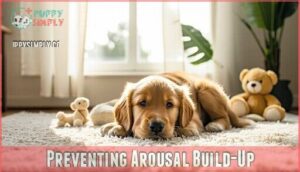This site is supported by our readers. We may earn a commission, at no cost to you, if you purchase through links.
 Teaching your puppy to be calm takes patience but gets easier with the right steps.
Teaching your puppy to be calm takes patience but gets easier with the right steps.
First, teach a “settle” command by rewarding your pup when they relax on cue. Next, manage excitement by identifying triggers, like visitors or loud noises, and redirecting their focus with a toy or treat.
Third, reward calm behavior—catch them in quiet, restful moments and offer praise or a snack.
Table Of Contents
- Key Takeaways
- Teaching Calm Behavior
- Managing Arousal Levels
- Rewarding Calmness
- Training Techniques
- Calming Methods
- Frequently Asked Questions (FAQs)
- How to teach a puppy calmness?
- At what age do most puppies calm down?
- Are there any products specifically designed to help puppies relax?
- Are there any approaches that work better for certain breeds of puppies?
- What age should puppies begin learning to be calm?
- How often should I practice calming techniques with my puppy?
- How can I tell if the calming techniques I am using are effective?
- How do I manage my puppys separation anxiety?
- Can diet influence a puppys ability to relax?
- What are the signs of an overstimulated puppy?
- Conclusion
Key Takeaways
- Reward your puppy for staying calm by using treats or praise during relaxed moments and avoid overstimulating them during training.
- Teach a "settle" command early by guiding your puppy into a relaxed position, rewarding them, and gradually increasing the duration.
- Identify and manage excitement triggers like visitors or loud noises by redirecting your puppy’s focus with toys or treats.
- Use daily mental and physical exercises, like puzzle toys or walks, to manage energy and promote calm behavior.
Teaching Calm Behavior
You’ll find that teaching your puppy calm behavior isn’t just a luxury but a necessity for a peaceful home life.
You can transform your bouncy ball of fur into a relaxed companion by consistently rewarding settled moments and gradually increasing the duration they stay calm.
Transform your energetic pup into a calm companion by rewarding relaxation and extending their settled moments with consistency and care.
Importance of Settling Skills
Teaching your puppy to settle isn’t just a nice-to-have skill—it’s an essential life skill for creating a harmonious family life.
When your pup learns independent relaxation, you’ll both benefit tremendously.
- You can enjoy peaceful meals without begging or whining
- Your puppy develops confidence to relax even with distractions
- Indoor/outdoor settling creates versatility in any environment
Mastering these puppy calming techniques takes time, but the payoff is a companion who can self-regulate in any situation.
Increasing Settle Duration
Gradually extend your puppy’s settle time by adding just a few seconds with each training session.
Watch for weight shifting and comfortable relaxation as signs they’re truly settling in. Practice both on-leash and off-lead settling to reinforce this behavior in different contexts.
Consistency training is essential – short, regular sessions will build your pup’s calm behavior muscles faster than occasional marathon attempts. Remember, calm puppies aren’t born – they’re trained!
Strategies for Self-Settlement
Now that you’ve built up your pup’s settling skills, it’s time to teach them to settle on their own. A consistent daily routine helps puppies understand when it’s time to relax.
Try these puppy relaxation methods:
- Introduce a clear "Finished" signal to mark the end of playtime
- Provide appropriate chew toys for independent occupation
- Gradually reduce your assistance as they master self-soothing
These calm puppy training techniques will help your furry friend learn valuable self-settlement skills. Mental stimulation is equally important for managing energy levels, for more information visit Mental stimulation.
Managing Arousal Levels
You’ll need to manage your puppy’s excitement levels to avoid the chaos that comes with over-stimulation.
Learning to identify your pup’s arousal triggers and teaching them to self-regulate will transform your frantic furball into a calmer companion.
Triggers of Over-Excitement
Your puppy’s excitement can skyrocket from everyday triggers you mightn’t expect.
Everyday moments can ignite unexpected excitement in your puppy, turning simple triggers into lively bursts of energy and chaos.
Seeing other dogs during walks, anticipating your return home, or engaging in tug games can all spark over-excitement.
Environmental stimuli like unexpected noises or moving targets (your hands and feet) often escalate playtime into a frenzy.
Even excessive physical exercise can sometimes amp up your puppy rather than tire them out.
Overexcitement in dogs is often mistaken for happiness, but it can actually indicate behavioral imbalance, which can lead to a behavioral imbalance and should be addressed to prevent further issues, ensuring a healthy and happy relationship with your puppy, and promoting overall wellness.
Reducing Arousal Techniques
Arousal triggers, like barking or excitement, can overwhelm puppies. Reducing puppy hyperactivity starts with simple environmental modifications.
Try closing blinds, using white noise, or offering calming signals like a soothing voice. Puppy calmness exercises, like gentle fetch or relaxation techniques, work wonders.
Many owners also find environmental calming solutions helpful for anxious pets. Routine establishment helps too—consistency fosters impulse control and puppy mental stimulation for a relaxed, content pup, which is key to achieving puppy calmness and overall relaxed atmosphere.
Preventing Arousal Build-Up
Keeping your pup’s energy balanced starts with reducing triggers and managing anticipation.
Limit stimuli by using strategies like closing blinds or playing soft music.
Controlled playtime and routine consistency are key for managing puppy energy.
Incorporate calm puppy commands and puppy calmness exercises into daily activities.
These simple puppy training tips can keep arousal levels low and promote a peaceful environment.
Breeds like pointers often require consistent daily exercise to manage their energy, which is crucial for maintaining balanced energy and ensuring calm puppy behavior.
Rewarding Calmness
Rewarding calmness is one of the simplest ways to teach your puppy how to relax.
By recognizing and rewarding moments of tranquility, you’ll show your pup that staying calm pays off.
Principles of Rewarding Calm Behavior
When teaching calm behavior, timing is everything.
Reward the calm puppy using silent rewards and positive reinforcement.
Consistent calmness starts with recognizing and rewarding inactivity.
Try these tips:
- Sprinkle bites discreetly when they’re relaxed.
- Avoid direct praise; let actions speak.
- Reinforcement timing matters – reward immediately.
- Practice rewarding inactivity to reinforce calm behavior naturally.
Arousal avoidance supports lasting calmness!
Capturing Calm Moments
Quiet observation helps you spot moments of calmness. Place treats near your pup when it’s naturally relaxed. Clicker timing is key—mark the moment your puppy rests or sighs with relaxation. Reinforce calm behavior without interaction. Gradually introduce this during peaceful times.
Capturing calmness turns chaos into serenity, with consistent practice.
| Step | Action | Benefit |
|---|---|---|
| 1. Observe | Watch for calmness | Builds self-settling awareness |
| 2. Treat Placement | Quietly reward | Encourages relaxation |
| 3. Clicker Timing | Click and reward | Reinforces calmness instantly |
| 4. Stay Neutral | Avoid excitement | Maintains calm environment |
| 5. Repeat Often | Be consistent | Develops lasting calm behavior |
Reinforcing Desired Behaviors
Positive reinforcement works wonders when shaping calmness in puppy training.
Use consistent cues paired with a clicker introduction to capture moments of calm behavior.
Reward-based training teaches your pup what works!
Operant conditioning fundamentals explain how a dog’s actions have consequences.
- Offer verbal praise quietly when they’re relaxed.
- Use treat reward schedules to reinforce behavior.
- Gradually reduce rewards over time.
- Stay consistent to build lasting habits.
Training Techniques
Training your puppy to stay calm takes patience, consistency, and the right methods.
With techniques like positive reinforcement and clicker training, you’ll help your pup relax and develop lifelong self-control.
Positive Reinforcement Methods
To shape behavior with positive reinforcement calming, focus on treat delivery and perfect reward timing.
When your pup relaxes, offer consistent cues paired with treats or verbal praise.
Make puppy calmness training a daily habit.
Reward-based training isn’t magic, but it’s effective! Calm puppy behavior grows naturally when rewards highlight relaxation, teaching them tranquility pays off, and that relaxation is key.
Clicker Training Techniques
Clicker training is a game-changer for puppy training.
The Clicker Introduction starts simply: click, then treat.
Timing Precision matters—click when your pup shows calm puppy behavior to reinforce it.
Marking Behavior with the click encourages repetition.
Shaping Calmness happens over time as you reward relaxing moments.
This positive reinforcement calming approach turns your wiggly pup into a chill companion!
Many owners find success using specific training products.
Implementing Calmness Training
Start calmness training by rewarding your pup whenever they’re relaxed.
Avoid excitement during treat delivery—just quietly place it nearby.
Ignore any activity that follows; consistency reinforces independence.
Use these methods:
- Reward with treats when your puppy looks peaceful.
- Stay silent to avoid overstimulation.
- Walk away after rewarding them.
- Practice consistent reinforcement of calm puppy training methods daily.
Calming Methods
Keeping your puppy calm starts with the right techniques, including exercise, training, and building self-control.
You’ll teach them to relax in any situation by combining physical activity, mental stimulation, and clear commands, which helps in building self-control.
Physical Exercise Benefits
Daily walks or playtime create wonders for your puppy’s energy levels.
Exercise isn’t just about energy expenditure—it builds muscles, supports joint health, and promotes cardiovascular fitness.
Regular activity aids weight management while helping promote calm puppy behavior.
Check out this table:
| Benefit | Example Activities | Why It Helps | Frequency |
|---|---|---|---|
| Energy Expenditure | Fetch, Tug Games | Relieves excess energy | Twice daily |
| Muscle Building | Short Runs | Strengthens muscles | 3-4x a week |
| Joint Health | Slow-paced Walks | Eases stiffness | Daily |
| Cardiovascular Fitness | Chase Play | Boosts stamina | 15-20 mins/day |
Adding physical activities aids puppy training and promotes overall calmness.
Mental Exercise Importance
Mental stimulation is key to calming your puppy.
Engage their brain with cognitive enrichment like puzzle toys, scent work, and training games. These activities keep boredom at bay while enhancing focus and obedience.
Incorporate them into puppy training routines to see noticeable improvements in puppy behavior modification. Consider enrichment through play for added mental stimulation.
Remember, balanced mental and physical exercise is one of the best puppy training tips!
Obedience Training for Calmness
Obedience training builds impulse control and creates calm puppy techniques you’ll love.
Focus training, like Sit and Stay, reinforces routine establishment and command hierarchy, helping your dog relax.
Consistency’s importance can’t be overstated—your pup thrives on clear expectations.
With puppy training tips and a little patience, puppy obedience training becomes an enjoyable way to foster dog training calmness and harmony.
Starting early with basic obedience training can prevent bad habits and help establish a strong foundation for calmness.
Teaching a Settle Command
Building on obedience training, teaching calm behavior starts with a “Settle” command.
Begin in a quiet spot, use treats to guide your puppy into a relaxed position, and softly say “Settle.”
Gradually extend the duration as they improve, manage distractions carefully, reinforce progress with a steady schedule, and address any settling hiccups.
These puppy training tips help with calming puppies, even at night, and are essential for their development.
Frequently Asked Questions (FAQs)
How to teach a puppy calmness?
Start by rewarding calm moments with treats or praise.
Use quiet environments for practice, avoiding overstimulation.
Gradually increase distractions, stay consistent, and teach cues like ‘settle‘.
Relaxed puppies grow into balanced, happy dogs.
At what age do most puppies calm down?
Most puppies start to calm down around 12 to 24 months, as maturity kicks in.
Energy levels vary by breed, but consistent training, mental stimulation, and patience help speed the process.
Hang in there—it’s temporary!
Are there any products specifically designed to help puppies relax?
You can try calming aids like pheromone diffusers, weighted blankets, or anxiety vests designed for puppies.
Chew toys with calming scents or orthopedic beds also help create a peaceful environment for relaxation and comfort.
Are there any approaches that work better for certain breeds of puppies?
Think of training as tailoring a suit—some breeds need more patience or creativity.
High-energy breeds like Border Collies thrive on structured tasks, while calmer breeds like Bulldogs benefit from consistent, low-stimulation techniques for relaxation.
What age should puppies begin learning to be calm?
Start teaching calmness as early as eight weeks old.
Puppies are like little sponges, soaking up habits quickly.
Reward relaxed behaviors often, and keep sessions short.
It’s all about building calmness into their routine early.
How often should I practice calming techniques with my puppy?
Teaching calmness is like brewing the perfect cup of tea—it takes consistency and patience.
Practice calming techniques daily in short, 5-10 minute sessions.
Spread these sessions throughout the day to reinforce relaxation effectively.
How can I tell if the calming techniques I am using are effective?
You’ll know your calming techniques are working when your puppy settles faster, stays relaxed longer, and shows fewer signs of arousal like jumping or barking.
Watch for relaxed body language, like sighs or resting.
How do I manage my puppys separation anxiety?
Ease separation anxiety by creating a predictable routine with short departures.
Leave your puppy with a chew toy or puzzle to keep them busy, and avoid making goodbyes or returns overly emotional, keeping things calm.
Can diet influence a puppys ability to relax?
What your puppy eats can absolutely affect their ability to relax.
A balanced diet, rich in proteins and low in artificial additives, supports calm energy.
Avoid sugary treats—they’re the canine equivalent of a caffeine buzz, which can negatively impact your puppy’s ability to relax and support a balanced diet.
What are the signs of an overstimulated puppy?
Like a soda shaken too hard, an overstimulated puppy bursts with zoomies, relentless barking, jumping, biting, or frantic pacing.
They struggle to focus, ignore commands, and might even chew or nip uncontrollably.
Conclusion
Transforming your wild puppy into a calm companion isn’t magic—it’s purposeful training. With these 4 ways to teach your puppy to be calm, you’ll create a balanced, relaxed dog.
Teaching the settle command, managing triggers, rewarding calm moments, and using effective training techniques are game-changers. Consistency is key—puppies crave clear guidance.
Stay patient, celebrate small wins, and soon your once-energetic pup will settle like a pro. A calm puppy equals a happier home for everyone, which is the ultimate result of effective training.















